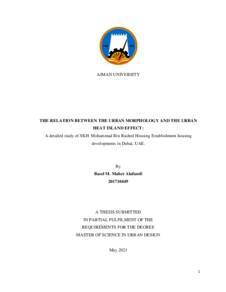وثيقة
download count
1.00
The social impact of distinctly designed urban residential neighborhoods of Dubai Using space syntax to evaluate morphological discrepancies
الناشر
Ajman University
تاريخ النشر (نص حر)
2020
اللغة
الأنجليزية
مدى
72 Leaves
الملخص
Abstract
The city is a complex web of living and non-living entities that drastically impact each other and evolve together. As urbanization rapidly takes over the primary share of our ecosystem, the contemporary city is under immense pressure to accommodate and nurture a healthy socio-economic and environmentally balanced future. Dubai is a unique phenomenon of “instant” urbanization with the bulk of the city being realized under the contemporary urban planning era. As the city aimed to radically transform itself into an urban enchantment, its urban forms naturally reflect the same exhibitionism.
Contemporary urban planning has been criticized extensively for its optical top to bottom approach, in inverse of traditional planning; which is oft attributed with more successful cities. With the bulk of most cities being swathed by residential projects and the influence of environmental nurture on society, this thesis intends to explore the impact of the various existing spatial configurations in Dubai from the lens of the space syntax theory; using the software, depthmapX. Four sites; Al Souk Al Kabeer, Al Rigga, International City — Phase 1 and The Old Town, were selected based on their contrasting street networks and spatial configurations. The morphologies of these sites are heavily reflective of the chronology of the overarching socio-economic purpose of development at the time of their inception.
A study of these different configurations gave deeper insight into how more successful residential neighborhoods can be shaped and what are the issues that need to be addressed in existing problematic zones. As traditional Arabian cities feature their own unique urban fabric and calls to protecting local values to sustain societies become more prominent in Dubai, many crucial questions were addressed in the research. Primarily it was found that, spatial configurations designed to cater to values of socially sustainable urbanism; particularly, pedestrian sensitivity, are not only more intelligible but also cohesively tie the fabric of the city at local neighborhood scales to a global scale. Further, it was assessed that a reimagining of values of the past with contemporary ideas; reflective through The Old Town project, can lead the way to more robust and sustainable future urban planning ideals.
المجموعة
مواد أخرى لنفس الموضوع

